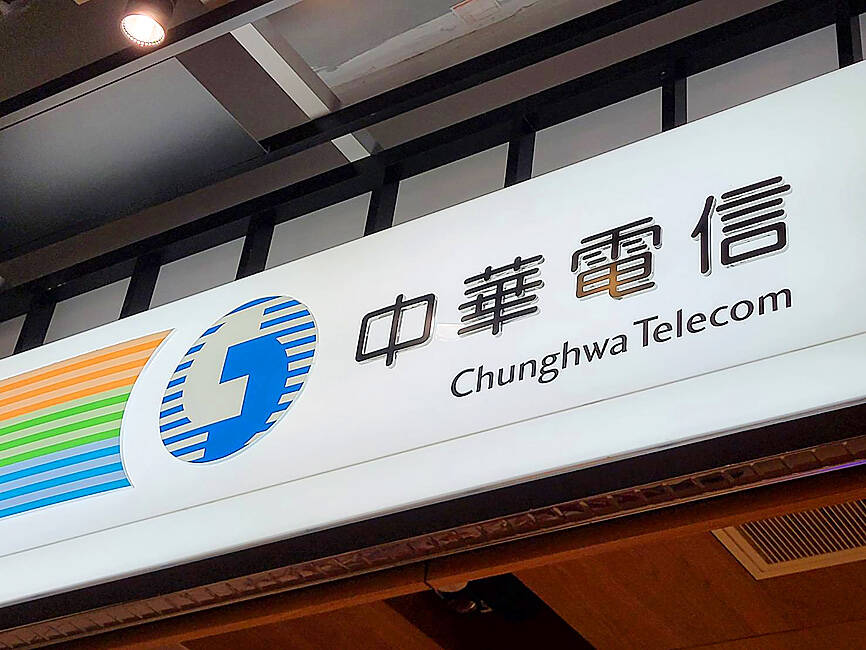Chunghwa Telecom Co (中華電信), the nation’s biggest telecom, yesterday said it plans to invest more than NT$4.6 billion (US$139.2 million) in a new trans-Pacific fiber-optic submarine cable with global partners, with an aim to boost network resilience and to cope with rising demand from artificial intelligence (AI) applications.
The telecom’s new investment came amid caution over submarine cable security after several cables linked to Taiwan have been sabotaged by foreign freighters or natural causes since the beginning of this year.
The new subsea cable network, dubbed E2A, is to be developed and invested by a consortium that comprises Chunghwa Telecom, SK Broadband Co, Softbank Corp and Verizon Business Global LLC, Chunghwa Telecom said in a statement.

Photo: CNA
The E2A, spanning 12,500km, would significantly enhance digital connectivity between Asia and North America, providing a robust backbone for AI applications, data centers and cloud services, ensuring high-speed connectivity across the Pacific Ocean as well as intra-Asia, the statement said.
The new submarine cable is scheduled to be ready for service in the second half of 2028, the statement said.
“Chunghwa Telecom will continue to enhance its resilient network infrastructure by integrating submarine cables, fiber optics, mobile communications, satellites and microwave technologies — forming a comprehensive ‘Sea, Land, Sky, and Space’ network,” Chunghwa Telecom chairman Alex Chien (簡志誠) said in the statement.
“Leveraging Taiwan’s strategic position as an Asia-Pacific information hub, we aim to attract international operators to establish a presence in Taiwan, further advancing AI-driven innovations and co-creation services to meet the evolving needs of our customers,” he said.
Crossing the Pacific Ocean, the E2A cable system would connect major digital hubs in Asia and North America, with landings in Yilan County’s Toucheng Township (頭城), South Korea’s Busan, Japan’s Chiba and Morro Bay in California, the statement said.
The cable would also connect with other upcoming cables in Taiwan, such as the SJC2 and Apricot, enabling diverse connectivity options, Chunghwa Telecom said.
This would strengthen Taiwan’s position as a key submarine cable hub in the Asia-Pacific region, it said.
It would further enhance the company’s overall network resilience, in addition to providing sufficient bandwidth to meet demand, it added.
The total cost of the submarine cable would be shared by all parties of the consortium, Chunghwa Telecom said.
The company has so far invested in more than 30 global submarine cables, with about 14 of them landing in Taiwan, it said.
The company has budgeted NT$32.36 billion for capital expenditure this year, up 12.3 percent from NT$28.82 billion last year.
Non-mobile capital expenditure is to increase 25.2 percent to NT$23.98 billion this year as Chunghwa Telecom aims to fund its investments in AI, data centers and new submarine cables, it added.

TRAGEDY STRIKES TAIPEI: The suspect died after falling off a building after he threw smoke grenades into Taipei Main Station and went on a killing spree in Zhongshan A 27-year-old suspect allegedly threw smoke grenades in Taipei Main Station and then proceeded to Zhongshan MRT Station in a random killing spree that resulted in the death of the suspect and two other civilians, and seven injured, including one in critical condition, as of press time last night. The suspect, identified as a man surnamed Chang Wen (張文), allegedly began the attack at Taipei Main Station, the Taipei Fire Department said, adding that it received a report at 5:24pm that smoke grenades had been thrown in the station. One man in his 50s was rushed to hospital after a cardiac arrest

SAFETY FIRST: Double the number of police were deployed at the Taipei Marathon, while other cities released plans to bolster public event safety Authorities across Taiwan have stepped up security measures ahead of Christmas and New Year events, following a knife and smoke bomb attack in Taipei on Friday that left four people dead and 11 injured. In a bid to prevent potential copycat incidents, police deployments have been expanded for large gatherings, transport hubs, and other crowded public spaces, according to official statements from police and city authorities. Taipei Mayor Chiang Wan-an (蔣萬安) said the city has “comprehensively raised security readiness” in crowded areas, increased police deployments with armed officers, and intensified patrols during weekends and nighttime hours. For large-scale events, security checkpoints and explosives

PUBLIC SAFETY: The premier said that security would be tightened in transport hubs, while President Lai commended the public for their bravery The government is to deploy more police, including rapid response units, in crowded public areas to ensure a swift response to any threats, President William Lai (賴清德) said yesterday after a knife attack killed three people and injured 11 in Taipei the previous day. Lai made the remarks following a briefing by the National Police Agency on the progress of the investigation, saying that the attack underscored the importance of cooperation in public security between the central and local governments. The attack unfolded in the early evening on Friday around Taipei Main Station’s M7 exit and later near the Taipei MRT’s Zhongshan

A car bomb killed a senior Russian general in southern Moscow yesterday morning, the latest high-profile army figure to be blown up in a blast that came just hours after Russian and Ukrainian delegates held separate talks in Miami on a plan to end the war. Kyiv has not commented on the incident, but Russian investigators said they were probing whether the blast was “linked” to “Ukrainian special forces.” The attack was similar to other assassinations of generals and pro-war figures that have either been claimed, or are widely believed to have been orchestrated, by Ukraine. Russian Lieutenant General Fanil Sarvarov, 56, head